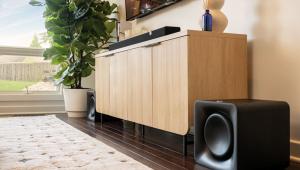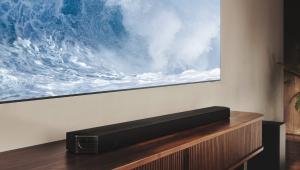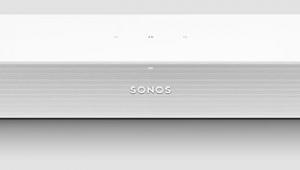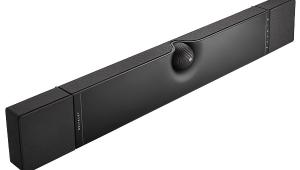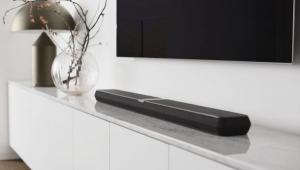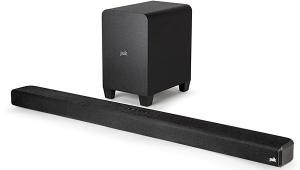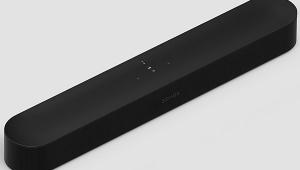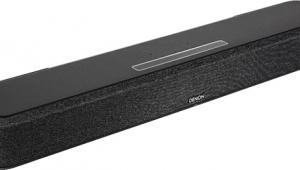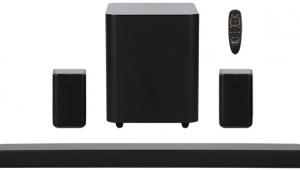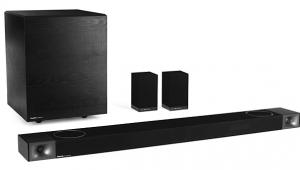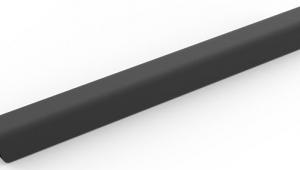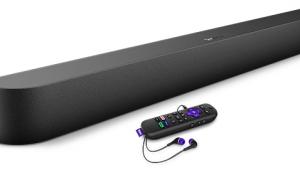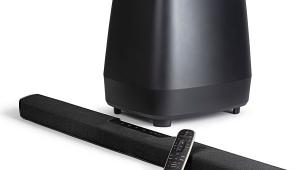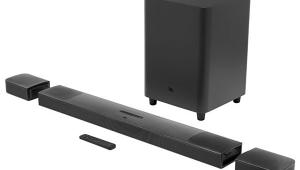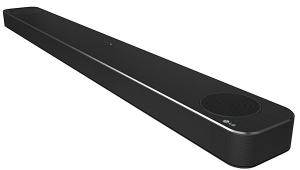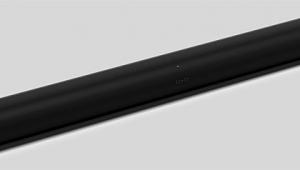Focal Dimension Soundbar System Review

AT A GLANCE
Plus
Fine tonal balance with genuine deep bass
Very substantial level potential
Elegant appearance
Minus
A few operational and hookup quirks (it’s French!)
No remote-control learn/teach scheme
THE VERDICT
A 5.1-channel system in soundbar packaging that combines tonal accuracy with impressive low-frequency response and power, plus surround as effective as we’ve heard from an all-up-front affair.
As recently as a couple of years ago, anyone shopping for an “audiophile soundbar” was in danger of being laughed off the lot. The bar scene was dominated by price-driven, mass-market models sold in big-box stores, and most of these were plastic jobs from the mega-mills of the Pacific rim, with just a smattering of somewhat more upscale choices from a few more serious American and Canadian brands. Today, soundbars have become such an important weapon in the rear-guard action of the serious-audio marketplace that high-end staples like Britain’s B&W and America’s own MartinLogan have planted the Union Jack and Old Glory on the soundbar battlefield. And now Focal has added the tricolor to the front lines.
OK, enough with the purple metaphors. Focal is a French maker with roots in high-end transducer design and manufacture, whose two-channel and surround loudspeaker offerings extend right into the bat-guano-goofy zone, a range where five figures are one digit too few. Righteously carrying the banner of liberty, fraternity, and, uh, that other thing, Focal’s Dimension soundbar is far more reasonably priced, but it is no more “just another bar” than a Citroën DS is “just another car.” For one thing, it’s a fully 5.1channel all-in-the-front design, though just as slim, on-wall shallow, and elegantly formed and finished as several 3.1 models we’ve seen recently. For another, Focal’s Dimension is, optionally, a two-piece system, available with a dedicated passive subwoofer engineered specifically for the soundbar (in a somewhat unusual form factor; more on that below). For a third, the bar has no user-adjustable parameters beyond volume, source selection, and a modestly ranged bass control; there are no listening modes, tone controls, or channel-level adjustments. This seems a deliberate design choice: The Dimension is intended for set-and-forget use, to be relied upon to deliver the proper listening experience from both stereo and surround-encoded (Dolby Digital and DTS) bitstream sources.
In that set-and-forget category, there are, however, four additional switches (each with three choices) on the Focal bar’s rather cramped rear panel that optimize it for its environment. The Position switch adapts its low-frequency shaping for on-wall, on-shelf/stand, or freestanding placement, and the Distance switch appears to adjust the Dimension’s surround DSP to direct the maximum surround effect to the desired listening distance. The Room switch controls surround effect level and (I think) treble balance for room characteristics, while Subwoofer offers settings for the Focal’s dedicated passive Dimension Sub, for a line-level powered subwoofer, or for no sub at all.
Setup
The Dimension soundbar itself is beautifully finished, with anodized brushed-aluminum, a tight-knit grille, and small gloss-lacquer end panels, which combine with its angular form to create a package I found very attractive. The right-hand panel is a disappearing, illuminated touchpanel control surface. Wave your hand over it (or press any key on the supplied card-type remote), and its markings appear; after a few seconds, they go dark again, except for a small pilot-light circle. Pretty cool.
 The soundbar employs five 4-inch full-range low-profile drivers (the bar’s grille didn’t appear to be removable, so I can’t tell you much more), and it claims six channels of power (from a trio of two-channel Class D modules) totaling 450 watts; one channel is dedicated to the subwoofer and is thus unused in a sub-less setup. The four outermost drivers share low-frequency chores (the center unit is channel-dedicated and gets its own internal enclosure), but otherwise, the five drivers reproduce the standard five LCRand-surround channels. Rather than counting purely on room reflections, Focal’s design exploits DSP shaping of—presumably—phase, frequency, and dynamic characteristics to produce its surround effect.
The soundbar employs five 4-inch full-range low-profile drivers (the bar’s grille didn’t appear to be removable, so I can’t tell you much more), and it claims six channels of power (from a trio of two-channel Class D modules) totaling 450 watts; one channel is dedicated to the subwoofer and is thus unused in a sub-less setup. The four outermost drivers share low-frequency chores (the center unit is channel-dedicated and gets its own internal enclosure), but otherwise, the five drivers reproduce the standard five LCRand-surround channels. Rather than counting purely on room reflections, Focal’s design exploits DSP shaping of—presumably—phase, frequency, and dynamic characteristics to produce its surround effect.
Unusually, the Dimension Sub is a slim, broad box that’s sized to lie flat directly behind the bar and function as an under-TV soundbase (or, optionally, to be deployed snugly up against a wall). I placed it on my stand, directly behind the bar and right under the wall-mounted TV, much the position it would be in when used as a base. Note that both units vent from their ends, so they’ll need some room to breathe if used in a cabinet. I mentioned that the sub is optional; the bar itself goes for $1,399, while a system with a subwoofer as reviewed here carries a $1,599 sticker.
Focal equips the soundbar with two HDMI 1.4 jacks, one input and one ARC-ready bidirectional port. This makes for a simple setup with an ARC-equipped (Audio Return Channel) screen, where the TV becomes the source selector. Otherwise, however, you’re restricted to a single HDMI source passing through the bar to the TV; the Dimension’s only other inputs are a single optical-digital and an analog stereo minijack. Users without an ARC TV are rather limited, either to these three inputs and two-step video selection or to using an A/V receiver (or HDMI switcher) with audio passthrough enabled to get the sound into the soundbar.
Even though my old Samsung TV is ARC-less, I mostly used the HDMI path with my pre/pro as a switcher. The bar’s inset, wall-mount-ready rear panel is very tight but mostly workable. The exception was the tiny, spring-grip terminals for the Dimension Sub’s speaker wire: frustratingly un-get-at-able, sized for elves, and gauged for surprisingly light cable. I struggled to insert 18-gauge wire. Grrr.

For initial impressions, I listened to the Dimension soundbar alone, without the subwoofer, and found an impressively balanced result. Male-announcer voices were crisp, uncolored, and articulate, without any of the boxy or honky tints common among mass-market small-driver bars. That said, there was a slight disconnect to midbass body, which sounded a bit exaggerated and separated from the mids and highs, as by a lack of output in the 100-hertz range. I monkeyed with the Position switch and lowered the soundbar’s bass control several clicks, which helped considerably but no more. However, connecting up the Dimension Sub and setting the bar’s Subwoofer switch appropriately—to send low-frequency signals exclusively to the woofer—solved the problem almost entirely. Still, even without the sub, the soundbar’s low end was notable for extension and for substantial output.
Music
Judged as a system, then, the bar-plus-sub was praiseworthy. On music, vocal tonalities and balance were outstanding, approaching those of my everyday three-way monitors. The setup was perfectly happy delivering customary TV fare at modest volumes with full, well-balanced sound, but even happier when more demanding audio came along. Well-produced pop music played back with surprisingly fine full-range balance—not just good for a soundbar but good, period. The stand-up bass intro to Rickie Lee Jones’ classic “Easy Money” was solid, woody, and evenly presented top to bottom, while the vocal rendering represented the singer’s papery nasality. Treble was extended, especially for a system with no dedicated tweeters. Elements that are rich in highs, such as 12-string guitar and jazz ride cymbals, retained excellent presence and clarity, though with a measurable loss of air and detail when compared with my monitors (which, if they were available today, would surely cost twice as much as the full Dimension system).
- Log in or register to post comments

